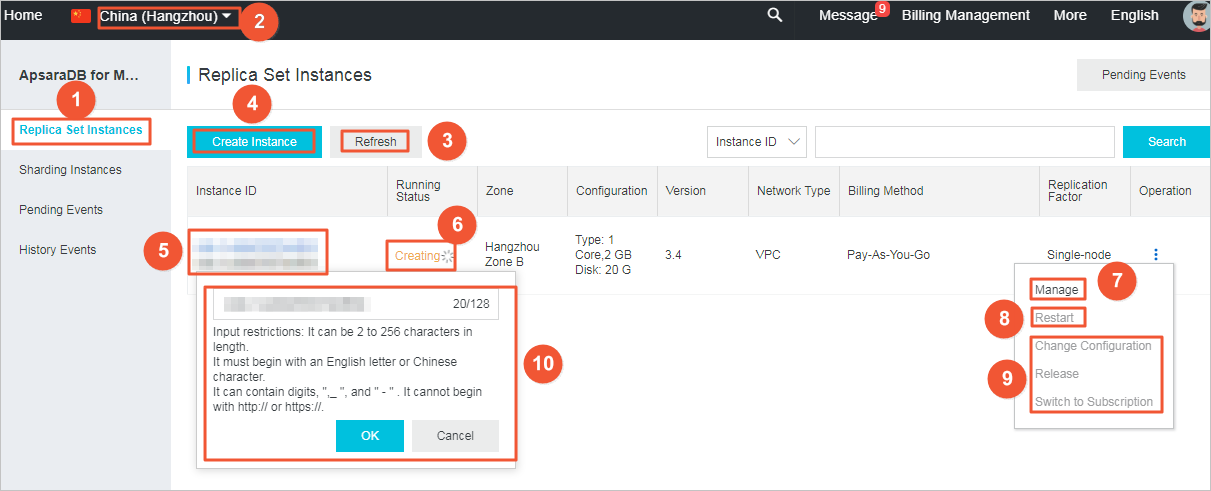This topic describes how to manage standalone instances in the ApsaraDB for MongoDB console. The ApsaraDB for MongoDB console is a web application that is used to manage ApsaraDB for MongoDB instances. In the ApsaraDB for MongoDB console, you can create ApsaraDB for MongoDB instances and configure IP address whitelists, passwords, and network types for the instances.
Prerequisites
An Alibaba Cloud account is used. To create an Alibaba Cloud account, visit the Create Your Alibaba Cloud Account page.
ApsaraDB for MongoDB console homepage
The homepage of the ApsaraDB for MongoDB console is the same for all standalone instances.

UI element description
| No. | UI element | Description |
|---|---|---|
| ① | Replica Set Instances | The Replica Set Instances page displays all standalone instances and replica set instances that are created within your Alibaba Cloud account in a specific region. |
| ② and ⑫ | Resource Groups and Regions | After you select a resource group and a region, all standalone instances and replica set instances that belong to the selected resource group and region are displayed on the Replica Set Instances page. |
| ③ | Create Instance | You can click the Create Instance button to create a standalone instance or replica set instance. For more information, see Create standalone instances. |
| ④ | Refresh | You can click the Refresh button to refresh the Replica Set Instances page. |
| ⑤ | Export | You can click the Export button to export the information about the standalone instances and replica set instances that you select. For more information, see Export the list of instances. |
| ⑥ | Instance ID/Name | You can click the ID of a standalone instance or replica set instance to open the Basic Information page of the instance. |
| ⑦ | Status | The Status column displays the statuses of standalone instances and replica set instances. Different instances may be in different states. |
| ⑧ | More icon | You can click the More icon in the Actions column of a standalone instance or replica set instance to show more options. Then, you can click Manage to open the page that displays details about the instance. On this page, you can manage the instance based on your business requirements. For example, you can view the basic information about the instance and configure backup and recovery for the instance. For more information, see View monitoring data and Configure a whitelist for an ApsaraDB for MongoDB instance. |
| ⑨ | Restart | You can click the More icon in the Actions column of a standalone instance or replica set instance to show more options. Then, you can click Restart to restart the instance. For more information, see Restart an ApsaraDB for MongoDB instance. |
| ⑩ | More icon | You can click the More icon in the Actions column of a standalone instance or replica set instance to show more options. These options provide entry points for you to perform various operations on the instance. For example, you can change the specifications of the instance and release the instance. For more information, see Configuration change overview and Release an instance or a node. |
| ⑪ | Edit icon | You can click the Edit icon in the Instance ID/Name column of a standalone instance or replica set instance to modify the name of the instance. If you do not modify the name, the name is the same as the ID. |
Procedure
- Log on to the ApsaraDB for MongoDB console.
- In the upper-left corner of the page, select the resource group and region to which the replica set instance belongs.
- In the left-side navigation pane, click Replica Set Instances.
- Find the standalone instance. In the Actions column, click the
 icon to show more options. Then, click Manage.
icon to show more options. Then, click Manage.
| Category | Item | Description | References |
|---|---|---|---|
| Top navigation bar | N/A | Allows you to migrate, back up, and restart the standalone instance. | |
| Left-side navigation pane | Basic Information | Displays the basic information about the standalone instance. The basic information includes the ID, network type, and specifications of the instance. You can change the specifications of the instance. | Overview |
| Accounts | Displays the information about the accounts of the standalone instance. You can reset the passwords of the accounts. | Reset the password of an account of an ApsaraDB for MongoDB instance | |
| Database Connections | Displays the endpoints of the standalone instance. | Connect to a replica set instance | |
| Backup and Recovery | Allows you to configure automatic backups, manage backup data, and create a standalone instance by using the data that is generated at a specific point in time. | Configure automatic backup for an ApsaraDB for MongoDB instance | |
| Monitoring Data | Displays the resource usage of the standalone instance. | View monitoring data | |
| Alert Rules | Allows you to configure alert rules for the standalone instance. | Configure threshold-triggered alert rules for an ApsaraDB for MongoDB instance | |
| Service Availability | Displays the distribution of the zones in which the standalone instance is deployed. | N/A | |
| Parameter List | Allows you to configure the parameters of the standalone instance. | Configure database parameters for an ApsaraDB for MongoDB instance | |
| Data Security | Allows you to configure security policies for the standalone instance. For example, you can configure IP address whitelists, SSL encryption, and transparent data encryption (TDE). | Configure a whitelist or an ECS security group for an ApsaraDB for MongoDB instance | |
| Logs | Standalone instances do not support the log management feature. | N/A | |
| CloudDBA | Allows you to analyze the standalone instance by using Database Autonomy Service (DAS). |